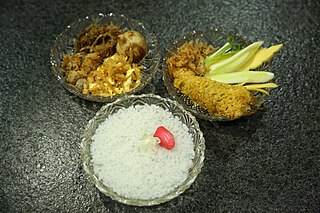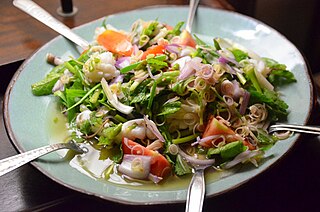Related Research Articles

Thai cuisine is the national cuisine of Thailand.

Fried rice is a dish of cooked rice that has been stir-fried in a wok or a frying pan and is usually mixed with other ingredients such as eggs, vegetables, seafood, or meat. It is often eaten by itself or as an accompaniment to another dish. Fried rice is a popular component of East Asian, Southeast Asian and certain South Asian cuisines, as well as a staple national dish of Indonesia. As a homemade dish, fried rice is typically made with ingredients left over from other dishes, leading to countless variations. Fried rice first developed during the Sui Dynasty in China.

Filipino cuisine is composed of the cuisines of more than a hundred distinct ethnolinguistic groups found throughout the Philippine archipelago. A majority of mainstream Filipino dishes that compose Filipino cuisine are from the food traditions of various ethnolinguistic groups and tribes of the archipelago, including the Ilocano, Pangasinan, Kapampangan, Tagalog, Bicolano, Visayan, Chavacano and Maranao ethnolinguistic groups. The dishes associated with these groups evolved over the centuries from a largely indigenous base shared with maritime Southeast Asia with varied influences from Chinese, Spanish and American cuisines, in line with the major waves of influence that had enriched the cultures of the archipelago and adapted using indigenous ingredients to meet local preferences.

Shrimp paste or prawn sauce is a fermented condiment commonly used in Southeast Asian and Southern Chinese cuisines. It is primarily made from finely crushed shrimp or krill mixed with salt, and then fermented for several weeks. They are either sold in their wet form or are sun-dried and either cut into rectangular blocks or sold in bulk. It is an essential ingredient in many curries, sauces and sambal. Shrimp paste can be found in many meals in Cambodia, Indonesia, Laos, Malaysia, Myanmar, the Philippines, Singapore, Thailand, and Vietnam. It is often an ingredient in dip for fish or vegetables.

The generic term for condiments in the Filipino cuisine is sawsawan. Unlike sauces in other Southeast Asian regions, most sawsawan are not prepared beforehand, but are assembled on the table according to the preferences of the diner.

Rice vermicelli is a thin form of noodle. It is sometimes referred to as "rice noodles" or "rice sticks", but should not be confused with cellophane noodles, a different Asian type of vermicelli made from mung bean starch or rice starch rather than rice grains themselves.

Thai fried rice is a variety of fried rice typical of central Thai cuisine. In Thai, khao means "rice" and phat means "of or relating to being stir-fried."

Laing, is a Filipino dish of shredded or whole taro leaves with meat or seafood cooked in thick coconut milk spiced with labuyo chili, lemongrass, garlic, shallots, ginger, and shrimp paste. It originates from the Bicol Region, where it is known simply as pinangat. Laing is also a type of ginataan, and thus may also be referred to as ginataang laing. Laing is commonly eaten as a vegetable side to complement meat or fish side dishes known as ulam in Filipino, which is normally paired with boiled white rice.

Ngapi is a pungent paste made of either fish or shrimp used in Burmese cuisine. Ngapi is typically made by fermenting fish or shrimp that is salted and ground then sundried. Like cheese, it can be distinguished based on main ingredient and regional origin. Ngapi can be distinguished by the type of fish used to make it. Ngapi can come from whole fish, from small fish or from prawns. Ngapi is a main ingredient of Lower Burmese cooking and is used as a condiment or additive in most dishes. Raw ngapi, with some exceptions, is not intended for direct consumption.

Sinangag, also called garlic fried rice or garlic rice, is a Filipino fried rice dish cooked by stir-frying pre-cooked rice with garlic. The rice used is preferably stale, usually leftover cooked rice from the previous day, as it results in rice that is slightly fermented and firmer. It is garnished with toasted garlic, rock salt, black pepper and sometimes chopped scallions. The rice grains are ideally loose and not stuck together.

Khao chae is "rice soaked in cool water". "Khao" means "rice" and "chae" means "to soak". Around the time of King Rama II, the recipe was adapted from a Mon dish and then modified. It was meant to be made and consumed in the hot season, from mid-March to the end of April. Ice was not then available in Thailand, so the water was kept cool during hot season by putting it in an earthenware vessel in a shaded place. Some old recipes call for the use of camphor to cool the dish.

Salads that are internationally known as Thai salads with a few exceptions fall into four main preparation methods. In Thai cuisine these are called yam, tam, lap and phla. A few other dishes can also be regarded as being a salad.

Khao khluk kapi is a flavorful dish in Thai cuisine that consists of primary ingredients of fried rice mixed with shrimp paste, the latter of which is known as "kapi" in Thai. The dish is typically served with several side dishes or toppings, such as sliced cucumber, sliced shallot, onion or purple onion, deep-fried or fried shrimp, shredded or thinly sliced sour green mango, chili peppers, deep-fried chili peppers, sliced thin egg omelet or crêpe, sweetened roasted pork, pork belly, Chinese sausage such as kun chiang, and mackerel, among others.
Shrimp paste fried rice can refer to:

Gising-gising, also known as ginataang sigarilyas, is a spicy Filipino vegetable soup or stew originating from the province of Nueva Ecija, and later absorbed in the cuisine of the province of Pampanga in the Philippines. It is traditionally made with chopped winged beans, and coconut milk spiced with labuyo chili, garlic, onions, and bagoong alamang. The name literally means "wake up, wake up". It can be eaten alone, on top of rice, or as a side dish to grilled meat dishes. It is a type of ginataan.

Taba ng talangka, also known simply as aligi, is a Filipino seafood paste derived from the roe and reddish or orange tomalley of river swimming crabs or Asian shore crabs (talangka).

Ginataang kalabasa, also known as kalabasa sa gata, is a Filipino vegetable stew made from calabaza in coconut milk and spices. It commonly includes shrimp and yardlong beans and either bagoong or patis. It can also be cooked with fish, crab, or meat and a variety of other ingredients. It is a creamy umami-laden dish that is naturally slightly sweet due to the calabaza. It is a type of ginataan.

Binagoongan is a Filipino cooking process consisting of vegetables or meat sautéed or braised in bagoong alamang, garlic, black peppercorns, and bay leaves. Some recipes also add pineapples, chilis, or coconut cream to balance the flavors. The dish is characteristically quite salty with a strong umami flavor, which is why it is always paired with white rice and never eaten on its own. It is very similar to pinatisan which is cooked with patis, one of the by-products of fermenting bagoong.

Ginataang langka, is a Filipino vegetable stew made from unripe jackfruit in coconut milk and spices. The dish includes a wide variety of secondary ingredients like seafood, meat, and other vegetables. The dish also commonly adds bagoong alamang and may be spiced with chilis or soured with vinegar. Notable variants of the dish are ginataang kamansi and ginataang rimas which use breadnut and breadfruit, respectively. Ginataang langka is a type of ginataan.

Aligue fried rice, also known as crab fat fried rice or aligue rice, is a Filipino fried rice dish cooked by stir-frying pre-cooked rice with crab fat, toasted garlic, spring onions, black pepper, rock salt, and optionally butter. It is traditionally a vivid orange-yellow color due to the crab fat. It can be combined with seafood like shrimp and squid and eaten as is, or eaten paired with meat dishes.
References
- ↑ "Bagoong Rice Recipe". Panlasang Pinoy. January 4, 2013. Retrieved April 10, 2020.
- ↑ Manalo, Lalaine. "Binagoongan Fried Rice". Kawaling Pinoy. Retrieved April 10, 2020.
- ↑ "Bagoong Fried Rice". Ang Sarap. January 24, 2011. Retrieved April 10, 2020.
- ↑ Belen, Jun (March 13, 2013). "How to Make Bagoong Fried Rice". Junblog. Retrieved April 10, 2020.
